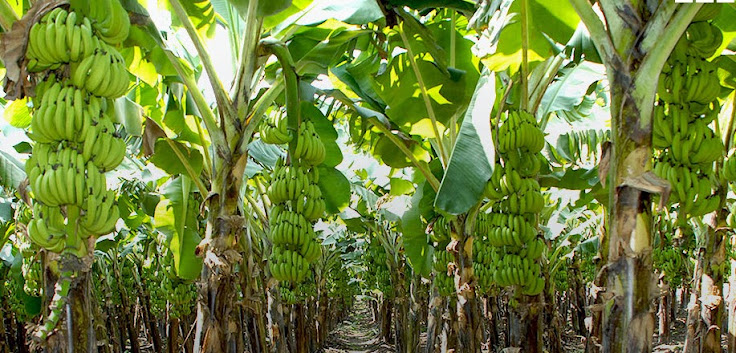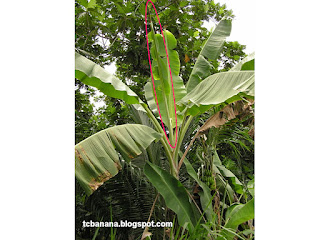Overcoming soil sodicity problem in banana
|
- Due to salinity and sodicity of soil, the banana plants may suffer from marginal chlorosis and necrosis of older leaves, lesser proliferation of roots and an yield reduction by about 30%. This problem may be rectified by applying 0.5 kg of gypsum + 15 kg of FYM along with 120 % recommended potassium per plant. The water drainage facility of the land should be improved to leach down the excess sodium and salts.
|
Overcoming flood damage in banana
|
- Open deep trenches between the plant rows for improving the drainage condition of the land.
|
- Give foliar spray of 2% potassium sulphate. After 15 days, give another foliar spray of 1% potassium nitrate.
|
- At the bunch development stage, give 2% potassium sulphate spray on bunch, two times with 15 day interval.
|
- During flood, the possibility of outbreak of Sigatoka leaf spot is more. As a prophylactic measure, give 0.1 per cent Propiconozole, 0.2 per cent Carbendazim and 0.25 per cent Mancozeb foliar sprays with 15 day intervals between each spray.
|
Overcoming wind damage in banana
|
- Banana crop can not tolerate the wind speed of even 30 km/hr. Banana being a shallow rooted crop requires proper propping with bamboo or casurina poles to avoid lodging during windy seasons. The supporting poles should be tied against the peduncle of developing bunches, so that it protects the plant from lodging during windy seasons and bears whole weight of developing bunch.
|
Overcoming the stem weevil problem
|
- The appearance of small holes and oozing out of gummy substances and fecal matter reveals the presence of stem weevil damage in banana.
|
- Give monochrotophos (150ml monochrotophos + 350ml water) injection.
|
If ratooning is adopted, remove and destroy the mother plants after bunch harvest.
|
| Overcoming the chilling injury during winter |
- Banana growing regions, where the night temperature is below 5oC during winter, protection of bunches with 100 gauge polythene sleeves of 6% ventilation is very essential.
|
| Overcoming the Erwinia rot |
- During summer, high soil temperature injures the pseudostem tissues, which are in touch with soil. Through these injuries, Erwinia bacteria may enter the plant and cause rotting.
|
- To avoid this, drench the soil around the plant with 2% bleaching powder solution.
|
| Overcoming the Wilt disease |
- The varieties like Karpuravalli, Rasthali, Ney Poovan and Monthan are susceptible to Panama Wilt.
|
- The soil around the wilt-affected plant should be drenched with 2% carbendazim solution. Or cabendazim filled gelatin capsule should be applied into the corm.
|
- The affected plant should be uprooted and destroyed out of the field. After uprooting, about 3kg of lime should be applied to the soil.
|
- The implements used in affected plants should be disinfected by spirit before using them in healthy plants.
|
| Contingency plan against natural calamities - Drought |
- The water scarcity situation during summer months could be overcome by adopting drip irrigation.
|
- Use of plant waste mulches viz., banana leaf mulches, sugarcane trashes, paddy straw mulches around the plants conserves soil moisture and also promotes production of more feeder roots.
|
| Protecting the peduncle from sun scorching |
- The fruit peduncle on exposure to sunlight suffers from sun scorching, which subsequently makes entry for pathogens that leads to rottig, poor uneven finger filling and ultimately breaking of the peduncle along with the bunch. Hence, the peducle should be fully covered using the 'boot leaf' that emerges just before the bunch.
|
|
| Propping / giving mechanical support to the plants against the wind |
By giving 'Double pole support' using bamboo or casuarina poles, the plants can be protected from uprooting by heavy winds during the hot months (April/May) or during summer showers locally called as 'Chiththirai chuli' and during monsoon winds.
|






.jpg)











 18:49
18:49
 Tissue Culture Banana Cultivation Technology
Tissue Culture Banana Cultivation Technology



 Posted in:
Posted in: 









